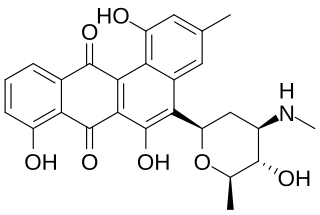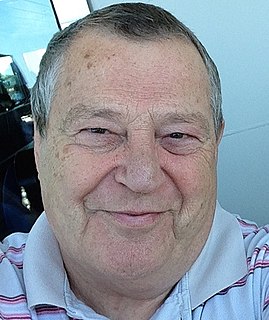Actinoalloteichus is a genus in the phylum Actinomycetota (Bacteria).

Mayamycin is a cytotoxic polyketide isolated from a marine Streptomyces.
Streptomyces isolates have yielded the majority of human, animal, and agricultural antibiotics, as well as a number of fundamental chemotherapy medicines. Streptomyces is the largest antibiotic-producing genus of Actinomycetota, producing chemotherapy, antibacterial, antifungal, antiparasitic drugs, and immunosuppressants. Streptomyces isolates are typically initiated with the aerial hyphal formation from the mycelium.

Dysidenin is a toxin from the sponge Lamellodysidea herbacea. It has a lethal effect on fishes and some marine organisms. It has been found to inhibit iodide transport in thyroid cells.
Dysidea arenaria is a species of marine sponge (poriferan) found in the Pacific Ocean. It is a member of the order Dictyoceratida, one of two sponge orders that make up the keratose or "horny" sponges in which a mineral skeleton is absent and a skeleton of organic fibers is present instead.
Streptomyces axinellae is a bacterium species from the genus of Streptomyces which has been isolated from the sponge Axinella polypoides in Banyuls-sur-Mer in France. Streptomyces axinellae produces axinelline A and tetromycin B.
Streptomyces haliclonae is a bacterium species from the genus of Streptomyces which has been isolated from the sponge Haliclona sp in the Chiba prefecture from the coast of Tateyama City in Japan.

Geodia barretti is a massive deep-sea sponge species found in the boreal waters of the North Atlantic Ocean, and is fairly common on the coasts of Norway and Sweden. It is a dominant species in boreal sponge grounds. Supported by morphology and molecular data, this species is classified in the family Geodiidae.
Streptomyces marinus is a bacterium species from the genus of Streptomyces which has been isolated from the sponge Haliclona sp. from the coastline from the city Tateyama in Japan.
Streptomyces microflavus is a bacterium species from the genus of Streptomyces which has been isolated from soil. Streptomyces microflavus produces nemadectin, fattiviracin A1, milbemycin and deoxyuridines. Streptomyces microflavus also produces the ionophore valinomycin. Streptomyces microflavus is also known to cause potato common scab disease in Korea.
Streptomyces rubrus is a bacterium species from the genus of Streptomyces which has been isolated from the sponge Haliclona sp. in Tateyama, Chiba in Japan.
Streptomyces spongiae is a bacterium species from the genus of Streptomyces which has been isolated from the marine sponge Haliclona in Tateyama in Chiba in Japan.
Streptomyces tateyamensis is a bacterium species from the genus of Streptomyces which has been isolated from the sponge Haliclona from the pacific coastline of the city Tateyama in the Chiba prefecture in Japan. Streptomyces tateyamensis produces the antibiotic thiopeptin B.
Streptomyces spongiicola is a bacterium species from the genus of Streptomyces which has been isolated from a sponge from the coast of Sanya City in China.
Streptomyces diacarni is a bacterium species from the genus of Streptomyces which was isolated from marine sponges from Sansha in China.
Dysidea etheria, commonly known as the ethereal sponge or heavenly sponge, is a species of lobate sponge within the class Demospongiae. This marine sponge is known for its light blue color and can be found in the Caribbean as well as off the coasts of Florida and Georgia. Like all other poriferans, D. etheria is capable of both sexual and asexual reproduction. The use of spicule collection as well as chemical defenses allows D. etheria to protect itself against predators such as the zebra doris and the orange knobby star. D. etheria is also known as a host species of the invasive brittle star Ophiothela mirabilis. Lastly, various molecular biology studies have utilized D. etheria to both study foreign particle transport in sponges and to isolate novel molecules.

Dysidea is a genus of sponges belonging to the family Dysideidae.

Robertus Wilhelmus Maria (Rob) van Soest, born in 1946, is a Dutch marine biologist. He works at the Naturalis Biodiversity Center and is also affiliated with the University of Amsterdam. He co-authored with John N. A. Hooper Systema Porifera: A Guide to the Classification of Sponges, a standard reference for sponge classification.
Streptomyces tirandamycinicus is a bacterium species from the genus of Streptomyces which has been isolated from a marine sponge from the coast of Wenchang.




